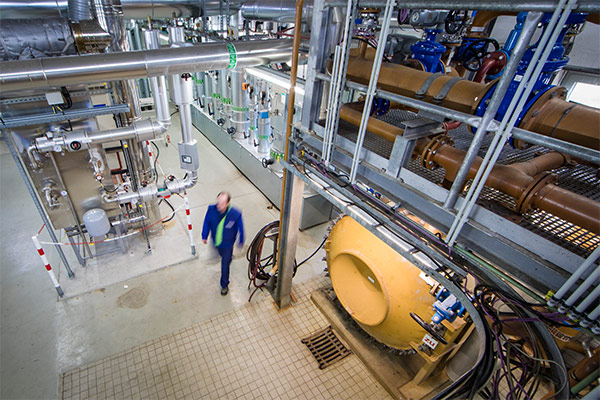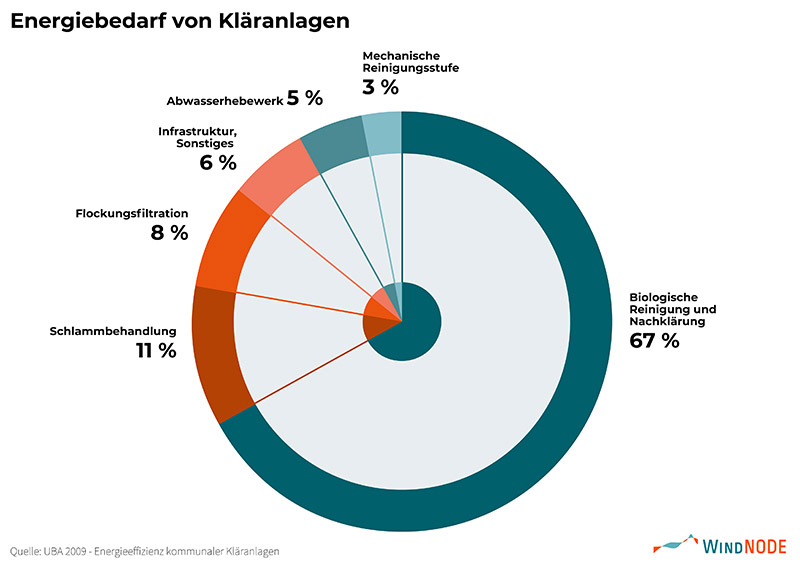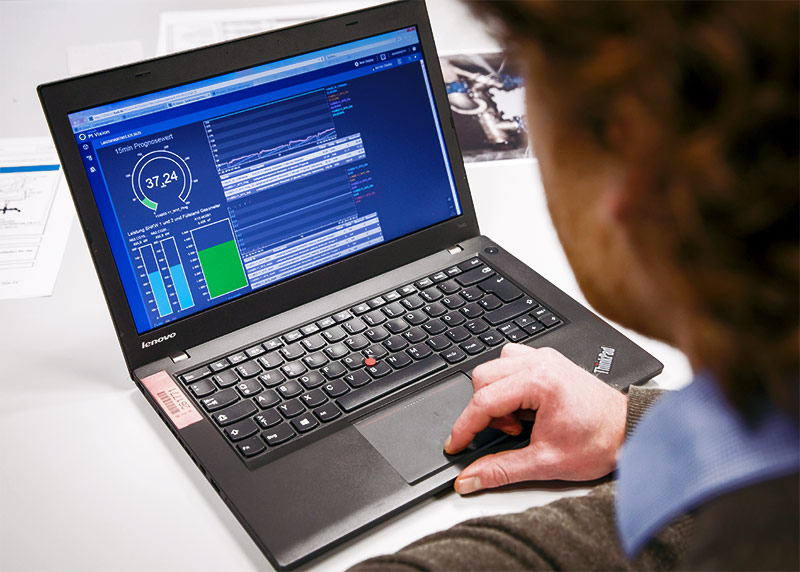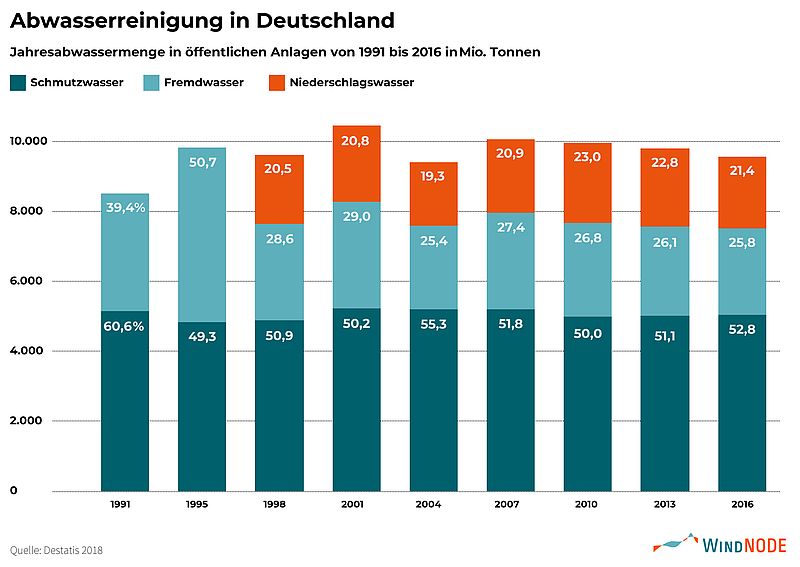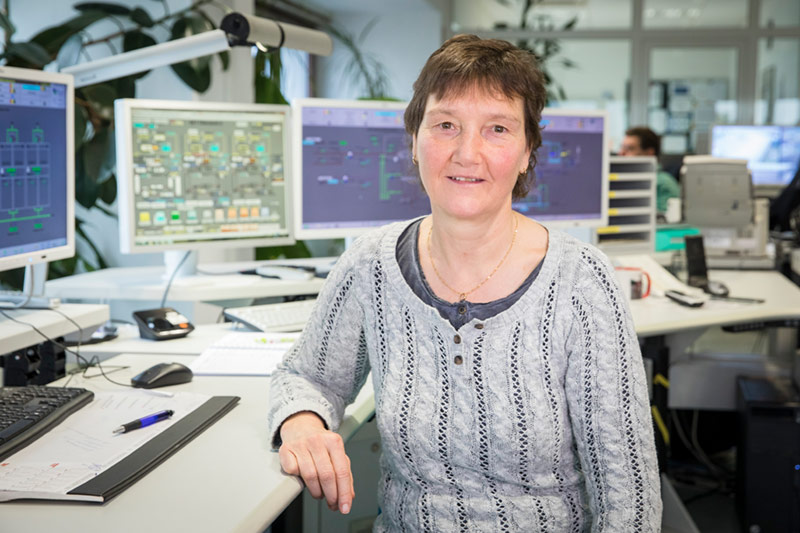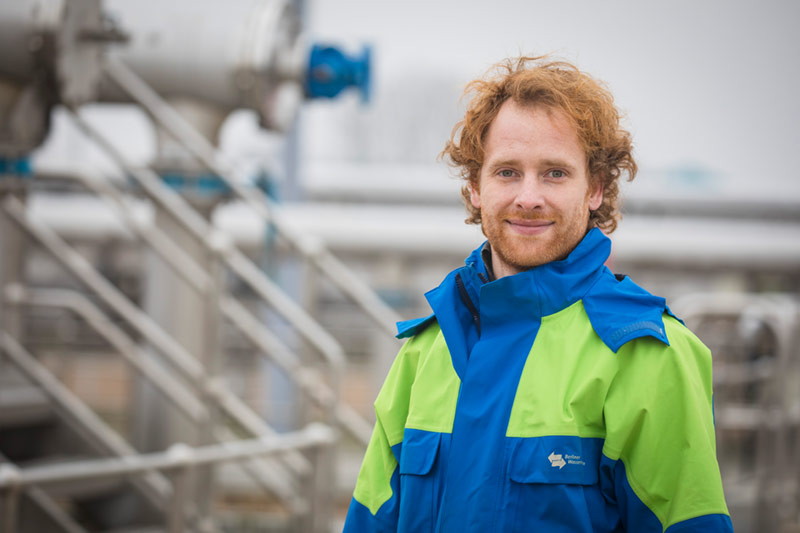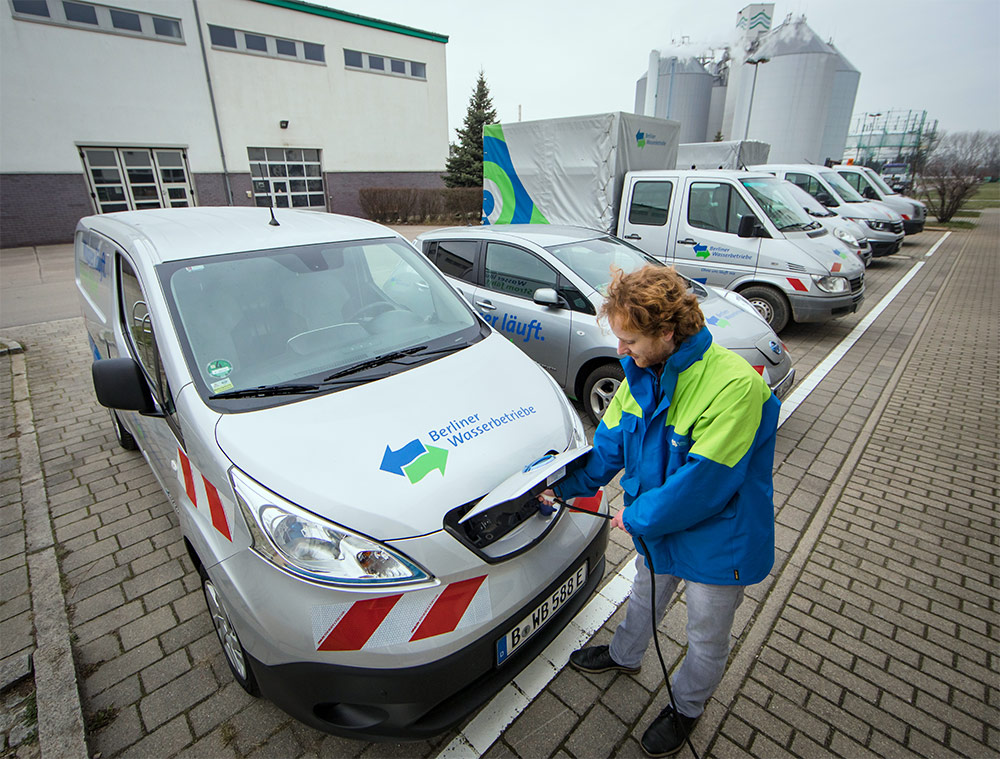Bubbling like a jacuzzi
“That is exactly the problem”, explains Regina Gnirß.
The head of research and development at Berliner Wasserbetriebe is standing between the reservoirs of the Schönerlinde wastewater treatment plant. At her feet, the water is bubbling like in a jacuzzi, while powerful fans blow air into the clarifiers to supply oxygen to the bacteria that purify the water. Above Gnirß’s head, the wind turbines should in fact be turning; the water utilities operate three units on site.
Should. In fact.
However, despite the strong wind, the multi-megawatt installations are only turning sluggishly in the breeze.
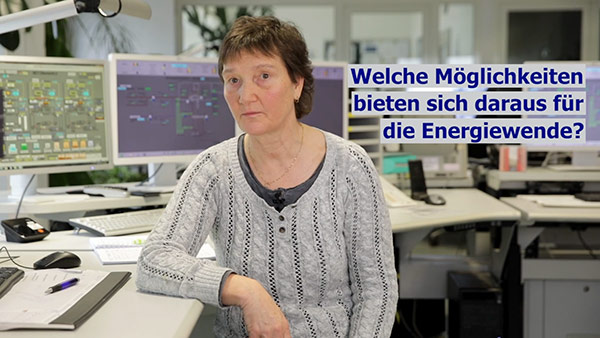
▶ Play
The Youtube video will only load and play after clicking. By clicking the video, you agree to Google's Privacy Policy .
Berliner Wasserbetriebe is one of the largest companies of the city. Almost 4,500 employees ensure that the metropolis is supplied with drinking water and that the discharge of precipitation, industry and households is purified. To this end, pumping stations throughout the city (the radial systems are more than a hundred years old) collect the wastewater and send it through a system of 9,500 kilometres worth of channels and pressure pipes to the six large treatment plants, which like Schönerlinde are located at the edge of the city.
There, it is purified step by step: mechanical purification, primary clarifier, biological purification with oxygen and bacterial sludge, secondary clarification. Six of such plants are operated by Berliner Wasserbetriebe; Germany has almost 13,000 of such plants (source: Destatis). However, the wind turbines on the premises of the Schönerlinde wastewater treatment plant are special.
Storing instead of burning sewage gas
Regina Gnirß remarks that despite the good wind conditions, the wind turbines are standing still - as so often happens, the system operator has to curtail the installations for one hour because there is too much wind power on the grid. Such situations, in which the consumption and generation of electricity from renewable sources do not match, are one of the central questions for WindNODE and therefore the subject of many WindNODE projects.
After all, the more electricity from renewable sources is fed into the 50Hertz grid area, the larger the following two challenges become: firstly, the optimal balance between generation and consumption, for which the consumer is made ever more responsible, and secondly, the management of grid bottlenecks created due to the temporary overload on the grids. One of the answers is: flexibilities on the consumer side. Berliner Wasserbetriebe shows how this can work.
“Follow me”, says Regina Gnirß and opens the doors to the inconspicuous machine hall on the vast premises of the wastewater treatment plant. Machine noises wash over us and the inside offers a precisely planned disorder of silver thermally insulated pipes and brown sludge lines. “While the wind turbines outside are immobile, our cogeneration units are going at full blast”, shouts Gnirß over the din. Two 200 kilowatt motors of a combined heat and power (CHP) unit as well as an additional one on site boasting 500 kilowatt burn the gas from the digestion towers of the treatment plant. It would be better to have the wind turbines turn in order to supply the plant with electricity, and to store the gas for the next calm: there is definitely room enough in the large bell-shaped gas storage tanks at the edge of the plant. The two tanks hold at least 10,000 cubic metres of gas with an energy content of about 60,000 kilowatt hours (kWh). “However, we could also purify the gas and feed it into the German gas grid, in which case we would have an almost infinite storage volume”, states Regina Gnirß. For the energy transition, the interaction between gas and electricity needs to change. The first step towards this goal should be taken in WindNODE.
Constant monitoring of the good working order
“Where do you think most of the power is consumed in a wastewater treatment plant?”, asks Gnirß, after she walked from the loud machine hall to the quiet control room of the treatment station. The employees of the operating team face about a dozen monitors and keep an eye on the good working order: water supply, pump performance, oxygen content in the reservoirs, discharge values.
Most of the power? To pump water, we suppose. “Wrong: 70 per cent of the energy is consumed by the fans that blow air into the aeration tanks”, Gnirß corrects us. On the monitor in front of her, the diagram of one of these tanks can be seen; at Schönerlinde, these are over a hundred metres long. 1,300 cubic metres of air are currently being blown into them so that bacteria can transform the nitrogen-hydrogen bond ammonium into the nitrogen-oxygen bonds nitrite and nitrate. The indicator in the control room shows 1.9 milligrams of oxygen per litre of water.
Further on, two more fans respectively pump another 900 and 700 cubic metres into the tanks to lower the oxygen content at the back of the long tank by a third. This creates an oxygen shortage and the nitrite and nitrate react to form the harmless nitrogen N2 element, the main component of our atmosphere at almost 80 per cent.
Treatment plant as control power plant
“Our most important task is and remains to pump clear water back into the environment”, Gnirß starts by saying. “But we also have some room for play: in WindNODE, we have proposed a concept on how we respond to the electricity supply shortage and surplus in the grid by means of the power consumption of the treatment plant.” In the meantime, tests have shown that a treatment station can not only theoretically offer such ‘flexibility’, but that it can also work in actual practice. To this end, not only the large consumption units such as the fans for the aeration are used, but also the entire orchestra of the station’s power consuming units.
To explain this, Christopher Dreke, a doctoral student working on water utility projects, shows a graph on his ThinkPad. “First”, says Dreke, “one has to understand that a wastewater treatment plant does not run as regularly as a car going 100 km/h.” Similar to the consumption of electricity of a city, the wastewater volume also follows a typical ‘load curve’. “It is still so that most of the effluents are generated during the lunch break, when water is used in the city’s kitchens and bathrooms.” This ‘wastewater peak’ is felt in the treatment station a few hours later.
The treatment plant’s controls continuously respond to life in the metropolis: Together with the wastewater volume, the electricity demand of the pumps and fans rises and falls. During regular operation, the consumption of electricity varies between 2,000 kWh and 2,700 kWh per quarter of an hour.
Within WindNODE, Berliner Wasserbetriebe took it upon itself to draw no more than 250 kWh per quarter hour from the public grid. If the wastewater treatment plant can keep this self-imposed maximum value for its power consumption as planned, then it can also react to the system operator’s demand and if necessary help keep the power grid stable.

▶ Abspielen
The YouTube video will only load and play after clicking. By clicking the video, you agree to Google's Privacy Policy.
Priority no. 1: clean water
“Over the past year, we have shown that it is possible”, says Dreke with one eye on the 250 kWh limit value. But what if a large amount of wastewater is produced by the city and the electricity demand is expected to exceed this value? To what extent can a treatment plant temporarily curtail its consumption units without risking the cleaning quality of the station?
In Schönerlinde, the team of Gnirß and Dreke started by listing which energy consumption units are the most expendable: during the winter, the heating of the plant’s corridors can be lowered for some time, as can the sand removers in the first tank, the pumps for the excess sludge, the recirculation pumps, the centrifuge motors and finally also the powerful fans for aeration.
Depending on the expected power consumption, these installations can now be activated or deactivated automatically. Of course, the devil is, as always, in the details: “For example, we had to grapple with the fact that due to the high start-up currents of the individual pumps, we cannot keep overshooting our 250 kWh target, if even for only a few seconds”, explains Dreke.
However, particularly delicate for the researchers was the performance of the fans that supply the bacteria with oxygen, as here, the scientists have to work under the critical eye of the employees in the control room. Regardless of the energy transition, their main concern always remains clean discharged water. “Nevertheless, throughout the year we can show that we can also perfectly clean the wastewater if we temporarily lower the oxygen content for the bacteria by 0.5 milligram or increase it by 5 milligrams”, head of research and development Regina Gnirß summarises. For a short time, the bacteria can effortlessly handle these ups and downs in oxygen supply.
Blueprint for all of Germany
This results in entirely new possibilities for the treatment plant: as the electromotors of the oxygen fans respond to control commands within seconds, the treatment plant could provide control power. BWB estimates the flexibility at about 15 per cent of the plant’s capacity. For the installations in Berlin, this results in 4 to 5 megawatts of control power. “What we are doing here is a blueprint for all communities! If it works here, it can work in the rest of Germany as well.”
For Gnirß, the newly discovered flexibilities are only the beginning. Today already, the water supply and disposal sector in Germany consumes about 6.6 terawatt hours (TWh) of electricity - as much as 1.6 million 4-person households (source: DWA). If, as recommended by the Federal Environment Agency[3], all large wastewater treatment plants are equipped with another purification level to remove pharmaceutical residues, the electricity demand will rise even further (source: UBA). The passenger car fleet as well, which many utilities are planning to replace by electric vehicles, offer opportunities to shift the consumption of electricity (see interview).
At the same time, Regina Gnirß is considering the potential of sewage gas produced by the installations, which nationwide amounts to another 2 TWh per year (source:UBA). Technically, the operation of gas storage units and cogeneration units is old hat. However, the gas price is so low, that it is simply not economically worthwhile to store the gas or feed it into the gas system. At the same time, the current Renewable Energy Sources Act (EEG) does not offer the incentives to simply use the wind power directly for the wastewater treatment plant. “In the end, it is also necessary to explain these challenges to the political level together with the other WindNODE partners”, says the head of research and development, “and in doing so develop the right rules for the energy transition.”
3 questions for...
What does WindNODE have to offer?
Here, we can use our wastewater treatment plants as living labs and show how much we can do for the energy transition and where we are limited by the current framework conditions. Through WindNODE and SINTEG, we can explain these challenges to the political level and in doing so help bring about changes to the current rules for the purposes of the energy transition.
Were there any unexpected successes during the project?
In the scope of WindNODE, we are expanding the controls of our treatment plant in Schönerlinde. So far, a treatment plant is operated with a sole focus on wastewater treatment. In the future, however, energy consumption will also be added as a control parameter. In this regard, we were for instance able to develop solutions for very practical problems, such as how to handle the start-up current peaks of the electromotors.
Where can you see this in action?
Tours of the Schönerlinde treatment plant can be arranged by e-mailingfuehrungen@bwb.de or by calling (030-8644-6393).
Half of our passenger cars are already electric cars: 82 classic small cars and six vans. We seek to increase this percentage to 80 per cent by 2021. Such a fleet will then have a storage capacity of up to 5.5 megawatt hours (MWh), which we want to integrate into the power grid in a smart manner. The first step toward this end are the 100 charging stations with smart software that we developed within WindNODE.
If we know the charging status of the batteries and if we know from the dispatch planning when the passenger car or van will be used again, then we can plan the charging process in the appropriate time window, for instance outside the early evening and only in the morning hours, when power consumption in the city is low. Or, thinking further ahead, also during times when a lot of wind or solar power is available on the grid.
We want to expand the software to charge the employees’ private cars and then also bill this electricity. As a next step, we are planning a cooperation with other infrastructure companies in the city. We already have a car sharing pool with Berliner Verkehrsbetrieben (BVG) and Berliner Stadtreinigung (BSR), which will be converted from diesel to electricity in the future. When the companies share the vehicles, the risks resulting from the higher procurement costs are better distributed and the cars rarely go unused.
In Steglitz, a wastewater pipe operating site of the water utilities, a bus depot of BVG and a recycling centre of BSR are located directly next to each other. The companies have also stated their plans to bundle their potentials in the field of e-mobility and energy management. These ideas were driven forward by WindNODE.


